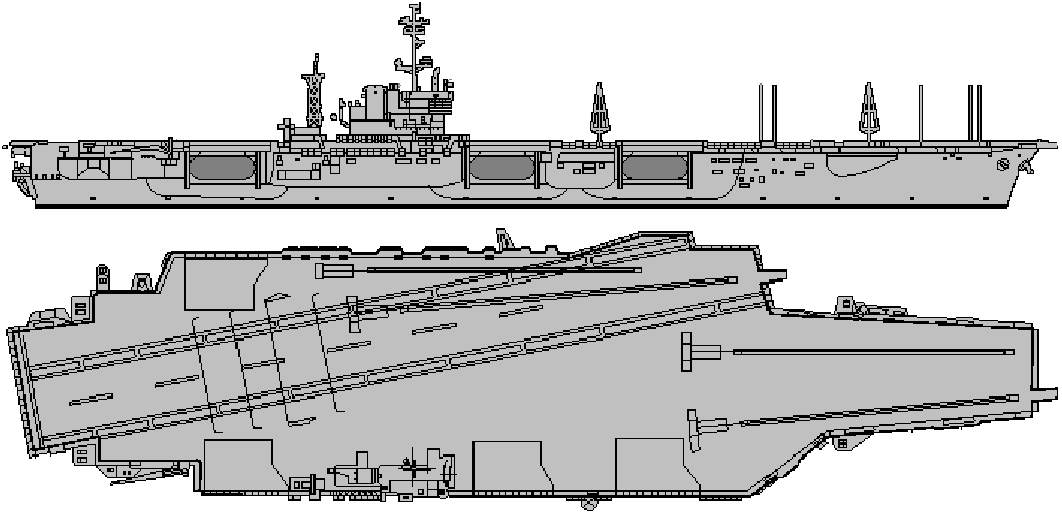
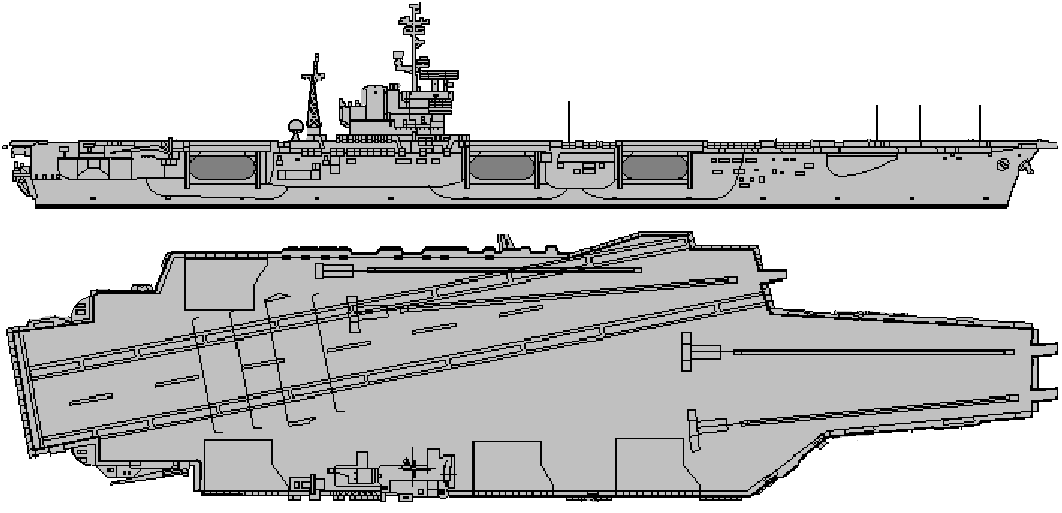

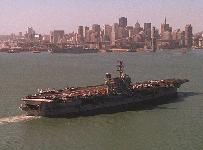

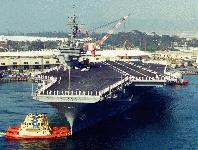
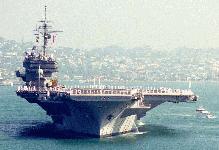
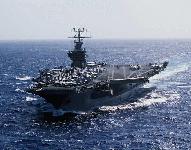
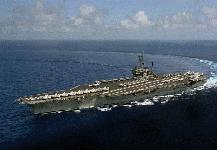
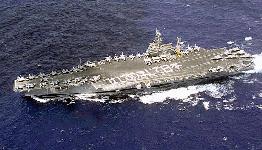
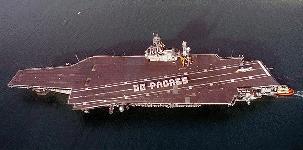




The aircraft carrier USS Kitty Hawk departed from Naval Air Station North Island on 06 July 1998, ending a 37 year relationship with the city of San Diego. USS Kitty Hawk (CV 63) departed to Yokosuka, Japan, on 15 July 1998 where it replaced USS Independence (CV 62) as part of a planned rotation of forward-deployed naval forces. USS Kitty Hawk arrived in Yokosuka in August 1998. Less than a week after arriving in her new homeport, civilian contractors from US Naval Ship Repair Facility (SRF), working with Kitty Hawk Sailors, began over 150 separate jobs. Projects range from repairing water-tight doors and hatches to replacing corroded deck drains. While a majority of the tasks are taking place in out-of-the-way areas, the largest job was replacing non-skid on the Flight Deck. Non-skid is an epoxy/sand compound used to protect the metal decking from corrosion and to provide traction for aircraft and personnel.
Built at the New York Naval shipyard as the second ship in the "Kitty Hawk" class of aircraft carriers, USS CONSTELLATION has more than 30 years of service, which have seen it sail from Yankee Station off the coast of Vietnam to the Gulf of Oman in the Indian Ocean. In February 1990, USS CONSTELLATION departed San Diego, returning to the East Coast for a three-year overhaul. The $800-million Service Life Extension Program (SLEP), completed in the Philadelphia Naval Shipyard in March 1993, added an estimated 15 years to the carrier's operational life. The overhaul saw upgrades to virtually every system on the ship, from the galleys to the engine rooms, and the flight deck to the anchors.
USS Constellation's Combat Systems Suite is one of the most advanced and capable in the fleet. SPS-48E three-dimensional fire control, TAS missile targeting and SPS-49 long-range air search radar systems operate together to allow the ship's Tactical Action Officer to accumulate and assess all hostile contacts. Enhanced by worldwide satellite communications and high frequency data links, information is available for anyplace, at any time. Other state-of-the-art systems, include the Aircraft Carrier Data system, Super High Frequency communications, Automatic Identification and Tracking, Joint Tactical Identification, and Positive Identification, Friend or Foe. The Electronic Chart Display and Information System (ECDIS) can show charts of most of the world's waterways with the simple click of a button. It automatically plots the ship's position by Global Positioning Satellite and keeps a complete record, alleviating yet another time consuming job aboard ship. Available on less than half of the Navy' ships, ECDIS was installed aboard Constellation before its most recent Western Pacific deployment. Also new to the ship is the Flat Panel Display. Seven such displays, strategically placed around Constellation's Bridge and Auxiliary Conn, give the crew instant access to every piece of ship control data available on one notebook sized screen. The displays also make complex computations, such as what course and speed will create enough head wind to launch aircraft from the waistcatapults, automatically.The recent integration of a Commercial Off-The-Shelf (COTS) computer system with the existing UNIX based system is the first step in a project that will ultimately provide a system which is easier to work with and maintain, and which will be substantially smaller and cheaper to operate. New software gives the Aerographer's Mates (AG's) the ability to detect holes in land-based radars and track overhead orbiting polar satellites and download their images. With the new computer, AG's can log onto the classified Internet and check the status of weather, download imagery from orbiting satellites, or "chat" with other Navy weather commands in real time. This new equipment is the prototype to a METOC system that's still on the drawing board - Tactical Environmental Support System Next Century (TESS NC). The Navy is currently using the TESS 3 version. With TESS NC, several Pentium processors in the OA Division office will be linked and provide the same functions as the current equipment, while generating a substantial savings of time and money.
USS Constellation's Intelligence Center (CVIC) recently augmented its intelligence capabilities with satellite communications and digital imagery technology. These new systems will allow the center to form a more complete and accurate picture of the battle space. The new satellite communication system Challenge Athena III (CA III) allows data to be transmitted and received at the rate of 1.54 megabytes per second, a near real-time connection with the rest of the battle group and other intelligence centers around the world. Digital imaging systems such as the Joint Services Imagery Processing System-Navy allow the battle group commander to plan and execute tactical Tomahawk Land Attack Missile (TLAM) strikes by receiving images over the CA III satellite. Other new imagery systems include a Vexcel Scanner and Digital Camera Receiving Station (DCRS). The DCRS, in combination with the F-14 Tactical Aircraft Reconnaissance Pod System (TARPS) allows CVIC to collect near real time digital images from an airborne F-14 aircraft. Finally, CVIC has installed secure video teleconferencing equipment which can use the CA III satellite. These new systems have made Constellation's CVIC a powerful, versatile intelligence gathering center able to operate independently in a variety of operational situations.USS CONSTELLATION returned to San Diego on July 22, 1993, following its third transit around Cape Horn at the tip of South America. On April 1, 1997 USS CONSTELLATION beginning a six month deployment to the Western Pacific, Indian Ocean and Arabian Gulf. The USS Constellation Battle Group replaced the USS Kitty Hawk Battle Group which had been forward deployed for six months to a variety of regions including the Western Pacific, Indian Ocean and the Persian Gulf. In October 1997 the USS Constellation battle group returned home on schedule after a highly successful six-month forward deployment to the waters of the Pacific and Indian Oceans and the Arabian Gulf. Carrier Air Wing Two (CVW-2), flew over 1,000 sorties in support of Operation Southern Watch enforcing the no-fly zone over southern Iraq.
USS America CV-66, a slightly modified variant of the Constellation, was de-comissioned on 09 August 1996 after a surprisingly short active career spanning three decades, and is presently in inactive reserve in the Naval Inactive Ship Maintenance Facility (NISMF), Philadelphia, PA. America returned from its last deployment 24 February 1996, where its squadrons flew 250 combat missions over the skies of Bosnia and Herzegovina. The ship and crew also distinguished themselves during Operation Desert Storm. America is the only carrier to have launched strikes against Iraqi targets from both sides of the Arabian Peninsula: Red Sea and Persian Gulf. The aircraft carrier was commissioned Jan. 23, 1965, at Norfolk Naval Shipyard. During its second deployment, America assisted with the rescue and medical treatment of crew members from the technical research ship USS Liberty (AGTR 5) after it was attacked by Israeli torpedo boats and jet fighters, June 8, 1967. America also completed three deployments off the coast of Vietnam, where it spent as many as 112 consecutive days on station.
The de-comissioning of USS America made room in the active fleet for the newly comissioned CVN-74 USS John C.Stennis. USS Constellation is slated for replacement by the new CVN-76 Ronald Reagan in 2003. USS Kitty Hawk is slated for replacement by the as yet un-named CVN-77 in 2008.
Specifications | |
| Power Plant | Eight boilers, four geared steam turbines, four shafts, 280,000 shaft horsepower |
| Length, overall | 1062.5 feet (323.8 meters) |
| Flight Deck Width | 252 feet (76.8 meters) |
| Beam | 130 feet (39 meters) |
| Displacement | Approx. 80,800 tons (72,720 metric tons) full load Approx. 78,500 tons (72,720 metric tons) full load CV-66 America |
| Speed | 30+ knots (34.5+ miles per hour) |
| Aircraft | 85 |
| Crew | Ship's Company: 3,150 - Air Wing: 2,480 |
| Armament |
Sea Sparrow missiles 3 Phalanx CIWS 20mm mounts |
| Combat Systems |
SPS-48C SPS-49 SPS-10f or SPS-67 3 Mk91 Fire Control SLQ-29 EW WLR- 1 ESM WLR-11 ESM |
| Unit Operating Cost Annual Average | ~$141,000,000 [source: [FY1996 VAMOSC] |
Ships | ||||||
| Name | Number | Builder | Homeport | Ordered | Commissioned | Decommissioned |
| Kitty Hawk | CV-63 | NYSB Camden | Yokosuka | 01 Oct 1955 | 29 Sep 1961 | 2008 |
| Constellation | CV-64 | New York NSY | San Diego | 01 Jul 1956 | 27 Oct 1961 | 2003 |
| America | CV-66 | Newport News | Norfolk | 25 Nov 1960 | 23 Jan 1965 | 09 Aug 1996 |










